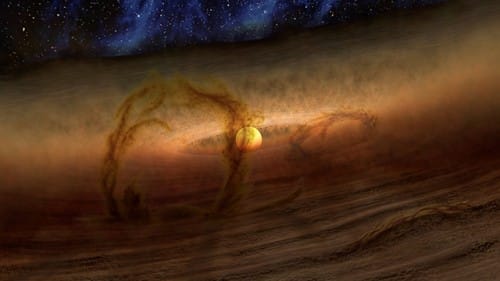The excess of infrared light in protoplanetary disks is due to gas and dust rising above the disk through giant magnetic loops like those seen on the Sun that absorb starlight and glow in infrared light.

Astronomers say magnetic storms in the gas surrounding young stars may explain the mystery surrounding the mystery of excess infrared light from the disks of young planets since 2006.
Researchers using NASA's Spitzer Space Telescope to study stars had a hard time answering the question: Why do stars emit more infrared radiation than they expected? The proplanetary disks surrounding young stars are heated by the starlight and glow with infrared light, but Spitzer discovered additional infrared light coming from an unknown source.
The new theory, based on XNUMXD models of planet-forming disks, offers a possible answer. Gas and dust rise above the disk through giant magnetic loops like those seen on the Sun that absorb starlight and glow in infrared light.
"If we could somehow miraculously stand on a protoplanetary disk and look at a star in the center through the disk's atmosphere it might look like a sunset," says Neil Turner of NASA's Jet Propulsion Laboratory in California.
The new model better describes how the material from which the planets are formed, which surrounds the star in a normally flat plane, is lifted up. These loops often become planets, asteroids or comets.
While the idea of magnetic atmospheres on protoplanetary disks is not new, this is the first time that this process has been linked to the mystery of excess infrared light.
According to Turner and his colleagues, the magnetic atmosphere is similar to that found on the surface of the Sun, where magnetic field lines form loops of solar flares that go out into space.
Stars are born from giant collapses of matter within clouds of gas and dust that continue to surround them as they contract under the weight of gravity. As the star grows, more and more material is drawn in towards it from the cloud, and the rotation flattens the remaining material into a swirling disk. Eventually planets form from the material in the disk.
In the 20s the Infrared Astronomical Satellite, a joint project involving NASA, began to find more infrared light than expected in young stars. Using data from other telescopes, the astronomers pieced together the presence of dust disks containing the material from which the planets are formed, but eventually it became clear that the disks alone are not enough to create the additional infrared light, especially in cases where the stars are many times more massive than the Sun.
One theory proposes that instead of a disk, the stars are surrounded by a vast halo of dust, which obscures visible light and re-radiates it as infrared light. However, recent observations from ground-based telescopes have led to the assessment that both a disk and a halo are necessary. Finally, three-dimensional computer models of the vortices in the disk showed that the disk has a hazy surface consisting of layers of low-density gas held by the magnetic field, similar to the solar loops supported by the Sun's magnetic field.
The new study puts the puzzle together by calculating how much starlight falls on the disk and its hazy atmosphere. The result is that the atmosphere absorbs and re-radiates enough light to account for all the excess infrared light.
"The material that hides the light of the star is not in the halo nor in the traditional disc but in the atmosphere of the disc held by the magnetic field" says Turner. "This magnetized atmosphere is expected to form when the disk drives gas inward to crash into the growing star."
In the coming years, astronomers will be able to try and test the ideas about the structure of the disk's atmosphere by using giant ground telescopes that will be connected together to interferometers. An interferometer combines and processes data from many telescopes to show finer details than any telescope can observe on its own. The spectrum of the gas swirling in the disks will be detectable from NASA's Sophia telescope, the ALMA Array of Millimeter and Submillimeter Telescopes (ALMA) in Chile, and NASA's James Webb Space Telescope due to launch in 2018.

2 תגובות
Stunning!
And to think that we discovered all this knowledge without the ability to investigate closely...
In my opinion, this mystery lies in the star's gravity and the various solar systems that affect the infrared effect